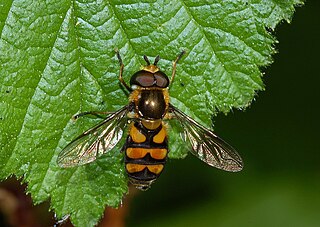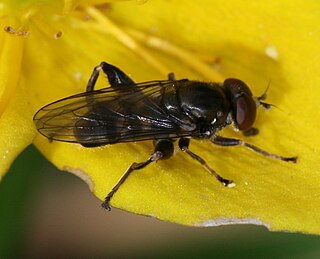
Hover flies of the genus Microdon are unusual among the Diptera. Like other members of the subfamily, they are myrmecophiles, meaning they inhabit the nests of ants.

Xylota segnis, The Brown-toed Forest Fly, is a common species of hoverfly.

Temnostoma bombylans is a species of hoverfly. Larva of this species feed in decaying wood of deciduous trees.

Didea, the lucent flies is a holarctic genus of black and yellow large sized flies 10–15 mm (0.39–0.59 in). belonging to the hoverfly family of Diptera. The larvae feed on aboreal aphids.

Parasyrphus is a genus of hover fly found in the holarctic area of the world including species like Parasyrphus tarsatus located in some very northern areas. Very few of the 31 identified species have known larvae. Of the known larvae most are predators of tree aphids with one, Parasyrphus nigritarsis, that feed on beetle eggs and larvae.

Sphaerophoria is a genus of hoverflies. Species slender 5.6-12mm long with extremely large hemispherical male terminalia after which the common name globetail has been created. There are bright yellow markings on head and thorax and usually on the abdomen but some species have a black abdomen. They can be found worldwide but are common in North America, Europe, Asia and Australia. There are over 73 described species.

Baccha elongata is a species of hoverfly in the genus Baccha.

Chalcosyrphus (Xylotomima) nemorum , the Dusky-banded Leafwalker, is a common species of syrphid fly with a Palearctic and Nearctic distribution. Hoverflies get their names from the ability to remain nearly motionless while in flight. The adults are also known as flower flies for they are commonly found around and on flowers, from which they get both energy-giving nectar and protein-rich pollen. Larvae have been found under the bark of Larix, Pinus and a variety of hardwoods.

Neoascia is a genus of small black and yellow or mostly black flies with a narrow abdomen near the thorax. They occur mainly in damp places among low herbage. The larva of Neosascia are flattened without oral hooks and a have a short posterior spiracular process or "tail" rat-tailed that is saprophagous. In 1925 Curran reviewed the genus Neoascia. In this work a key is provided and ten species are described including four new species some of which have later been determined to be synonyms.

Platycheirus discimanus, the Yellowfoot Sedgesitter is a small species of hoverfly. It is found across Europe and the Palearctic and in North America.

Platycheirus immarginatus, the Comb-legged Sedgesitter, is a common species of hoverfly. It is found in parts of northern Europe and northern North America.

Toxomerus politus, commonly known as the maize calligrapher, is a species of hoverfly. It is known from North, Central and South America. Although little is known about the early stages of this species, associations with corn have been noted. The adults and likely the larvae feed on the pollen of the corn plants.

Chrysotoxum pubescens the Yellow-throated Meadow Fly is a North American species of syrphid fly in the family Syrphidae.The adults are strong mimics of wasps. Larvae of this species has been described.

Xylota florum is a Palearctic species of hoverfly.

Brachyopa flavescens, The Yellow Sapeater, is a fairly common species of syrphid fly. It has been observed in northeastern North America. Hoverflies get their names from the ability to remain nearly motionless while in flight. The adults are also known as flower flies for they are commonly found around and on flowers, from which they get both energy-giving nectar and protein-rich pollen. Larvae for this genus are of the rat-tailed type. B.flavescens larvae have not been described.

Helophilus fasciatus, the narrow-headed marsh fly, is an abundant species of syrphid fly observed throughout the United States and Canada. Hoverflies can remain nearly motionless in flight. The adults are also known as flower flies for they are commonly found on flowers, from which they get both energy-giving nectar and protein-rich pollen. The larvae of this genus are associated with wet decaying organic material, particularly accumulations of decaying vegetation in ponds and mud and farmyard manure or silage. The adults of this species lays eggs on vegetation overhanging the water. The larvae hatch and drop into the water.

Syrphus knabi, the Eastern flower Fly, is an uncommon species of syrphid fly observed in the eastern United States and Canada. Syrphid flies are also known as Hover Flies or Flower Flies because the adults are frequently found hovering around flowers from which they feed on nectar and pollen. Adults are 7.2–12.9 mm (0.28–0.51 in) long. The larvae are predators of a variety of aphids in trees.

Helophilus obscurus , the obscure marsh fly, is a common species of syrphid fly observed throughout Canada and the northern United States and Rocky Mountains. Hoverflies can remain nearly motionless in flight. The adults are also known as flower flies for they are commonly found on flowers, from which they get both energy-giving nectar and protein-rich pollen. The larvae of this genus are associated with wet decaying organic material, particularly accumulations of decaying vegetation in ponds and mud and farmyard manure or silage the larvae of this species are not known.

Microdon abstrusus, the hidden ant fly, is a rare and local species of syrphid fly observed in central Pennsylvania. Hoverflies can remain nearly motionless in flight. The adults are also known as flower flies for they are commonly found on flowers though microdon species are seldom seen around flowers. Larvae have been noted in Formica exsectoides ant nests.
Total of 245 species either found or highly expected to be found in New York.



















